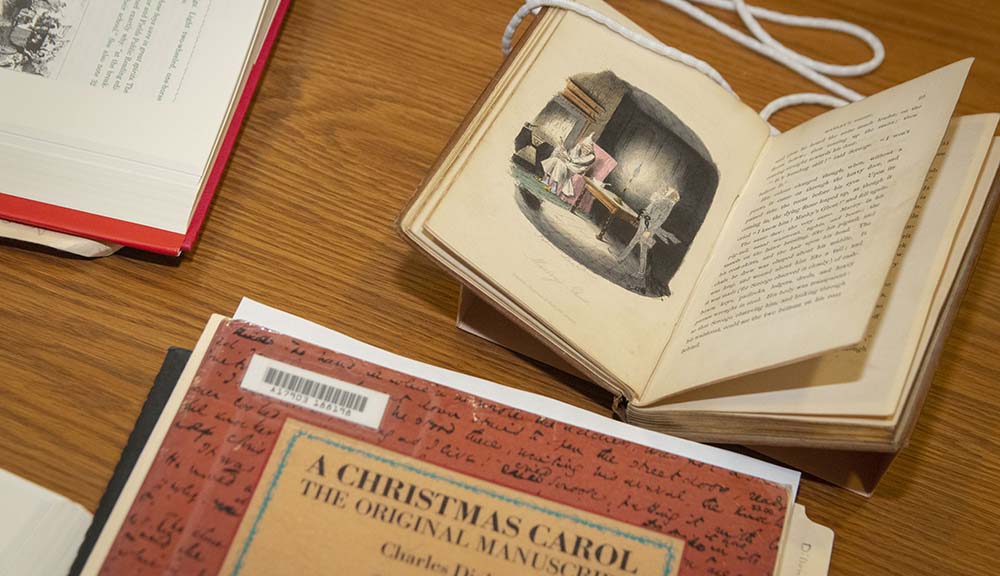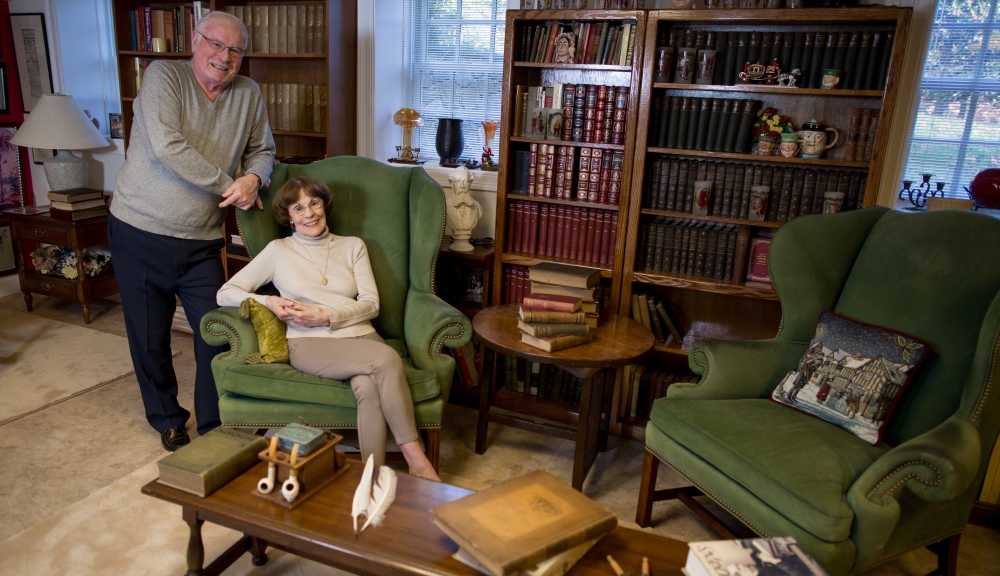On Dec. 19, 1843, Charles Dickens released a short work of fiction with a powerful and enduring message about redemption and charity. A Christmas Carol was an immediate success, selling out edition after edition and delighting critics and other literary luminaries. The book's power to engage and illuminate readers has remained undiminished for more than 170 years.
Arguably the most popular and influential fictional work about Christmas, the book also has its own fascinating backstory, notes Joel J. Brattin, professor of literature at Worcester Polytechnic Institute (WPI) and a noted Dickens scholar. “Studying A Christmas Carol provides an opportunity to gain insight into Dickens's creative process," Brattin says. "And we know that Dickens had multiple motivations for writing A Christmas Carol: he hoped it would revive his popularity, which had briefly wavered after years of great success; he wanted it to make money to help him ease his financial burden and support his growing family; he wanted to make a statement about the failings of society; and he wanted to create a tale that would inspire his readers to see Christmas as a time for generosity and charity. He didn't succeed in all of those goals, but his successes and failures, alike, make the story behind A Christmas Carol an interesting one."
As a gift for the upcoming holiday season, Brattin has assembled a collection of curious facts about A Christmas Carol, one for each of the Twelve Days of Christmas.
1. A Christmas Carol Began as a Social Manifesto. Unlike Ebenezer Scrooge, Charles Dickens was a champion of the poor and the downtrodden all his life. Recalling his own harsh experience working in a boot-blacking warehouse as a child, he was shocked and dismayed in the spring of 1843 by the brutal realities portrayed in the Second Report of the Children’s Employment Commission. He vowed to strike a “Sledge hammer” blow “on behalf of the Poor Man’s Child.” He considered writing a pamphlet, but quickly changed his mind and settled on a project he said would “come down with twenty times the force—twenty thousand times the force.” That project was A Christmas Carol. In fact, one of the book's most powerful images is the allegorical personification of Ignorance and Want (meaning poverty, rather than desire or greed), revealed as Man’s children by the Ghost of Christmas Present.
2. Dickens Had a Different Name in Mind for Tiny Tim. Would A Christmas Carol have tugged at our heartstrings in the same way if the character who cheerfully declares, "God bless us, every one!" had been named Fred? In fact, Dickens’s manuscript reveals that he originally intended to give the character that name, but then thought better of the idea. On the first two pages where the character is introduced, he crossed out Fred and substituted Tim or Tiny Tim. Later, he gave the name Fred (which was also the name of his younger brother) to Ebenezer Scrooge’s genial nephew—the one who wishes Scrooge a "Merry Christmas" in the book's first chapter.
3. The Book, as Dickens First Wrote It, Was Silent on Tiny Tim's Fate. At the end of the book, as we know it today, the narrator says of Ebenezer Scrooge that “to Tiny Tim, who did not die, he was a second father.” But that memorable line does not appear in the manuscript. Recognizing that his readers would want to know that, thanks to Scrooge’s change of heart, Tiny Tim would live, Dickens inserted the phrase in the proof stage.
4. The Illustrator Nearly Introduced a Big Mistake: In his first assignment for Dickens, illustrator John Leech created four black and white woodcuts for A Christmas Carol and four full-page etchings that were laboriously hand-colored. In one, he portrayed the Ghost of Christmas Present wearing a red robe, even though the manuscript said the garment was "deep green." The color was corrected before the book went to press.
5. Dickens Burned the Candle at Both Ends While Writing the Book. Dickens wrote A Christmas Carol in October and November of 1843 and published it in time for the Christmas season. At the same time, he was also writing his sixth novel, Martin Chuzzlewit, which was serialized in 20 monthly parts. The 12th installment went on sale that December and included an advertisement for A Christmas Carol. Writing both works simultaneously was a challenge: in a letter to a friend, Dickens described it as “pretty tight work.”
6. Iconic Elements of the Story Were Influenced by a Visit to Massachusetts. On a trip to the United States in 1842, Dickens toured the cotton mills in Lowell, Mass., and was impressed by working conditions there and by the young women who formed the labor force. He was especially taken with The Lowell Offering, a journal containing short fiction written by these "mill girls." Dickens was inspired by themes of memory and redemption he found in these stories. According to recently published scholarship by Natalie McKnight and her student Chelsea Bray, numerous passages from these writings, read with pleasure by Dickens, include “images, narrative structures, themes, and phrasings” suggesting that they influenced the “stream of thoughts and feelings that came to fruition” in A Christmas Carol.
7. Dickens Cut Short a Long Discourse on Hamlet. Famously, Dickens opens the book by declaring, "Marley was dead, to begin with." He tells the reader, "This must be distinctly understood, or nothing wonderful can come of the story I am going to relate.” To illustrate the point, he notes that to appreciate Shakespeare's Hamlet we must be "perfectly convinced that Hamlet’s Father died before the play began…." In the manuscript, he adds this note on Hamlet's character: “Perhaps you think that Hamlet’s intellects were strong. I doubt it. If you could have such a son tomorrow, depend upon it, you would find him a poser. He would be a most impracticable fellow to deal with; and however creditable he might be to the family after his decease, he would prove a special incumbrance in his lifetime, trust me.” Dickens deleted the amusing aside before sending the manuscript to the compositors.
8. Dickens Had a Questionable Business Model: Under financial pressure, Dickens was counting on A Christmas Carol to do well, and it did. But he insisted on high production values for his first Christmas book. The handsome hardbound volume included a title page printed in color, four hand-colored illustrations, and gilt-edged pages. In spite of these expensive refinements, it sold for just five shillings, a quarter of the price of a long Dickens novel. As a result, Dickens made only 230 pounds on the 6,000 copies printed for the first edition.
9. Dickens Lost His Shirt Because He Won a Lawsuit. The story gets worse. A plagiarized version of A Christmas Carol was put on the market by Lee and Haddock in early 1844, in violation of Dickens's copyright. Dickens won a lawsuit against the guilty publishers, but the victory was a bitter one: the publishers went bankrupt, and Dickens found himself liable for legal costs of 700 pounds, substantially more money than he had earned from the book's first printing. The experience may have provided inspiration for Bleak House, his ninth novel, which offers a biting indictment of the British judicial system.
10. The First Stage Adaptations Appeared Almost Immediately. A Christmas Carol has been the irresistible source for numerous adaptations for stage and screen, and countless amateur and semi-professional productions are staged every year, all around the world. The fascination with dramatizing Dickens’s tale began surprisingly early. On a single day in early February 1844, no fewer than three adaptations opened at the Adelphi, Strand, and Royal Surrey Theatres, and there were at least 12 versions staged in London by the end of the year.
11. Dickens Created His Own Stage Adaptation. He called it a “reading,” but we might call it a one-man show. In 1853, he collapsed and condensed the story so that the entire performance took about three hours; he eventually pared it down into a version that ran less than an hour and a half. His adaptation was enormously successful, and Dickens made a second career out of performing his own work on the stage, initially for a variety of charities, but from 1858 on for his own profit. His adaptation of A Christmas Carol was usually at the center of his public readings. He created individualized voices for each of the major characters, and moved audiences to tears and uproarious laughter. He brought the show to the United States on his second visit starting in late 1867, putting on 76 public readings in eighteen cities, the first in Boston on Dec. 2. In the final years of his life he gave many "Farewell Readings" in Britain. The professional readings brought in 45,000 pounds, or nearly half of Dickens's net worth at the time of his death in 1870.
12. Dickens Wrote Four Other Christmas Books. A Christmas Carol was Dickens’s first Christmas book, but he went on to write four more: The Chimes (1844), The Cricket on the Hearth (1845), The Battle of Life (1846), and The Haunted Man (1848). He also wrote many stories, sketches, and essays about Christmas (collectively referred to as the Christmas stories) in the 1850s and 1860s for the Christmas issues of his popular journals Household Words and All the Year Round.
At WPI Brattin teaches an undergraduate seminar on A Christmas Carol in which students compare a facsimile of the original manuscript to later editions to see how Dickens revised the work over time. This year, the students had the opportunity to work with a rare first edition of A Christmas Carol recently acquired by WPI's remarkable Robert D. Fellman Dickens Collection, for which Brattin serves as curator. "Viewing Dickens's hand-written manuscript and the changes made with his own pen offers a chance to see the imagination and the craftsmanship of Dickens at work," he says. "It also provides a fascinating glimpse of how the book we know today came to be, and of how it might have been different in some important ways."
For readers who'd like to delve deeper into the story of A Christmas Carol and the life and work of Charles Dickens, Brattin suggests exploring the digitization of the book's original manuscript, which is owned by the Morgan Library in New York. He also recommends these books: The Annotated Christmas Carol, ed. Michael Patrick Hearn; Charles Dickens, by Michael Slater; Oxford Reader’s Companion to Dickens, ed. Paul Schlicke; and Dickens and Massachusetts: The Lasting Legacy of the Commonwealth Visits, eds. Diana Archibald and Joel J. Brattin.



